'the moon is not the sun at night'
Miami Design District Pop Up Exhibition
5 - 30 January 2022
Head-Image
Goodman Gallery is pleased to present “the moon is not the sun at night”, a group presentation bringing together works by artists; Carlos Garaicoa, Kendell Geers, William Kentridge, Kiluanji Kia Henda, Kapwani Kiwanga, Grada Kilomba, Mateo Lopez, Naama Tsabar and Sue Williamson.
The presentation takes its title from a verse in the poem, ‘The Rose’, written by American poet Ben Lerner. “the moon is not the sun at night” is an evocation to rethink beliefs and accepted knowledge(s). It is an invitation to question our initial encounters with what we perceive. By blatantly stating what is “known” (that the moon is not the sun), an element of doubt is cast on our awareness, allowing a process through which known facts can be questioned, falsified or even made true again. Through varying methods of opposition works in the exhibition challenge accepted frames of reference. At first glance, Tsabar’s work appears as paintings or drawings but through closer observation, they reveal themselves to be intricate sound pieces that contradict their natural character. For Nhlengethwa, the sonic and the visual travel
alongside each other, influencing and affecting each other. In Garaicoa’s work, history and memory are intermingled to suggest ways in which truth and fiction can become conflated.
Re-memory is threaded onto the image where tree structures turn into spectral structures — they are there but also not there. Similarly, Neshat considers the historical alongside the contemporary by examining the complexities of women’s identities, both through their personal and public lives. While Kiwanga draws attention to the manner in which architecture is constructed to regulate behaviour and restrict spatial freedom, Kia Henda tests the limits of freedom (and by extension confinement) by pointing to the absurdity of restrictions on the movement of people — which fail against other species. Lopez’ ‘Sillas Núcleo (two chairs)’ straddles both activation and functionality, offering audiences a gesture of hospitality - the ability to sit and rest - alongside a visual experience. For Masamvu and Hlobo, the process of transfiguration (the figure into abstraction or found objects into new materials) allows for a deeper engagement with methods of making. Both Kilomba and Geers, reach into the chambers of history to excavate colonial legacies of fetishisation, plunder and death. Kentridge and Williamson offer us models of how to reflect on history’s untranslatability — suggesting multiple ways in which multiple mediums (postcards and the opera) can be reinterpreted and reread.
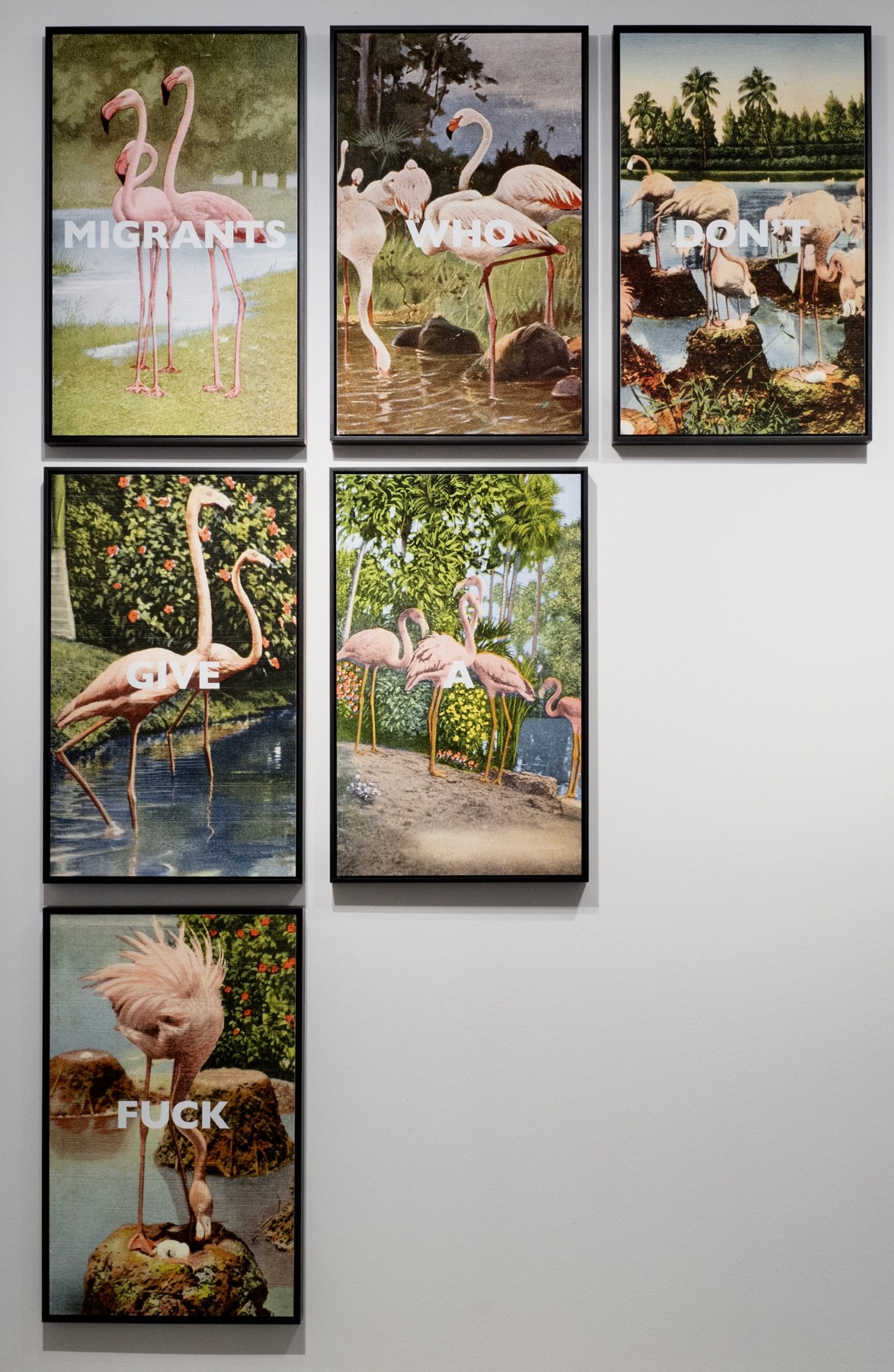
Kiluanji Kia Henda
Migrants Who Don't Give a Fuck
2019
Silkscreen and inkjet print Work (each): 100 x 63 cm STD 4/5
Edition of 5
The theme of migration and mobility is evoked by the image of flamingos, birds with a
nomadic lifestyle which for the artist symbolize migration as a human, free and universal
phenomenon. Migrants Who Don't Give a Fuck is made up of vintage postcards of pink
flamingos in various natural settings. Each postcard corresponds to a word that makes
up the sentence of the title, ironically testifying to independence from rules and
regulations that can limit their freedom of movement. The work is a poetic image of the
animal kingdom, presented as a territory of absolute autonomy from the human one.
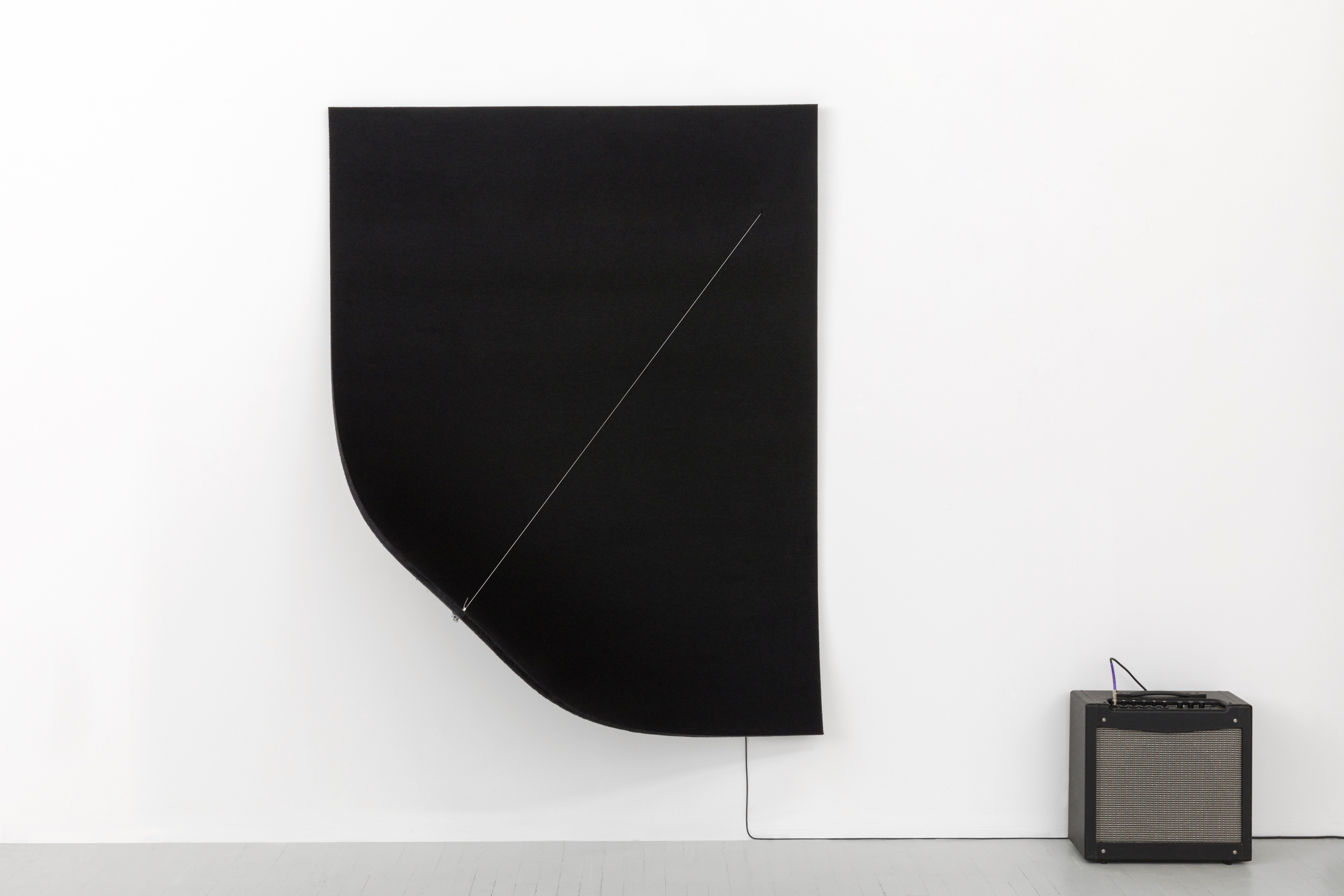
Naama Tsabar
Work On Felt (Variation 9) Black
2021
Carbon fiber, epoxy, wood, felt, microphone, guitar amplifier
Work: 181.6 x 141 cm
Unique
In this ongoing series of work, Naama Tsabar transforms raw industrial felt into modifiable stringed instruments. Through the addition of carbon fibre and guitar tuning pegs, the felt pieces take on new features that contradict their natural character. The work recalls the post-Minimalist art of the 1970s, extending its application by merging minimal aesthetics with performativity. Viewers are invited to directly engage with the works by plucking the strings and creating a new acoustic landscape. The works output sound through human encounter —tightening or loosening the strings changes the degree of the bowing of the sculptures as well as the sound they emit. The transformative nature of the work is such that the appearance of the sculptures, their erectness or flatness, directly corresponds to the pitch they produce. Reflecting on the use of felt as a material in her earlier works, Tsabar notes; “I was thinking about Robert Morris’s post-Minimalist gravity felt sculptures, and the deadening of sound in relation to Joseph Beuys’s felt suit for a piano. My first two pieces were on the floor, and in late 2015 I moved up to the wall.”
[Bomb Magazine, Sculpture and Sound: Naama Tsabar Interviewed by Naomi Lev, 2018].
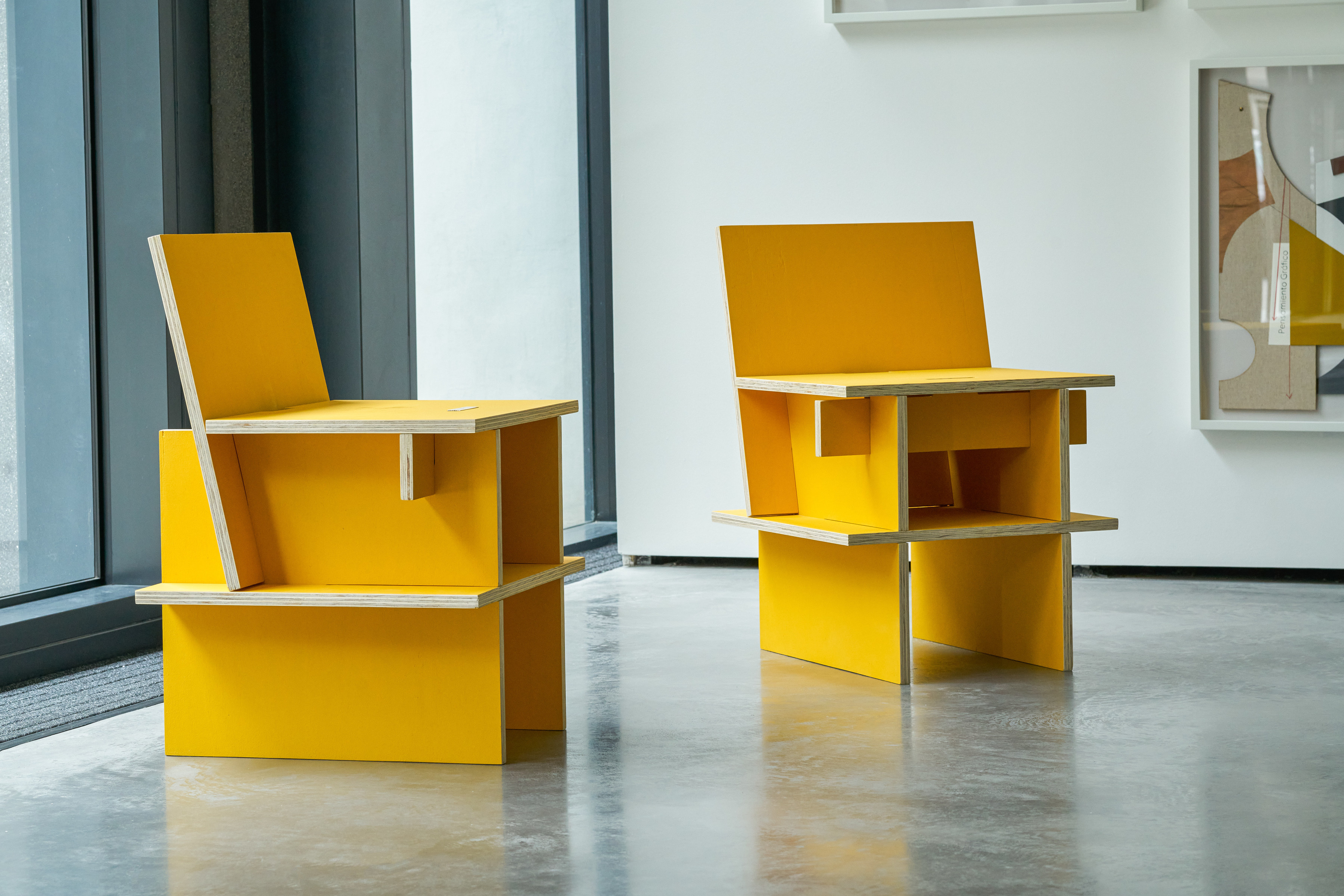
Mateo López
Sillas Núcleo (two chairs)
2020
Wood, turmeric & acrylic paint, varnish
Work: 74 x 50 x 50 cm
Flatpack each chair: 50 x 50 x 10 cm
Unique
“For quite a few years I have been thinking about my role as an artist, the use and
purpose of an artwork, as well as its activation and functionality.
Over time, I began using less rationality and more affection, emotion and hospitality as
part of my approach to making art. That’s why I usually include a gesture of hospitality
in my exhibitions, such as a piece of furniture to sit or lay down on. The idea being to
spend time and remind yourself that you are not there just to watch, you are an active
part of it.
These two chairs, titled Sillas Núcleo, replace the chairs the gallery usually has in the
space to host visitors. They are very simple chairs comprising six interlocked pieces. If
you were to explode out all the individual pieces into their individual parts floating in the
space, the chromatic Turmeric yellow might remind you of Hélio Oiticica’s Grande
Nucleo. This work is a homage, and a reference to Oiticica and that generation of artists
experimenting with the idea of a radical approach to art.”
- Mateo López, 2020.
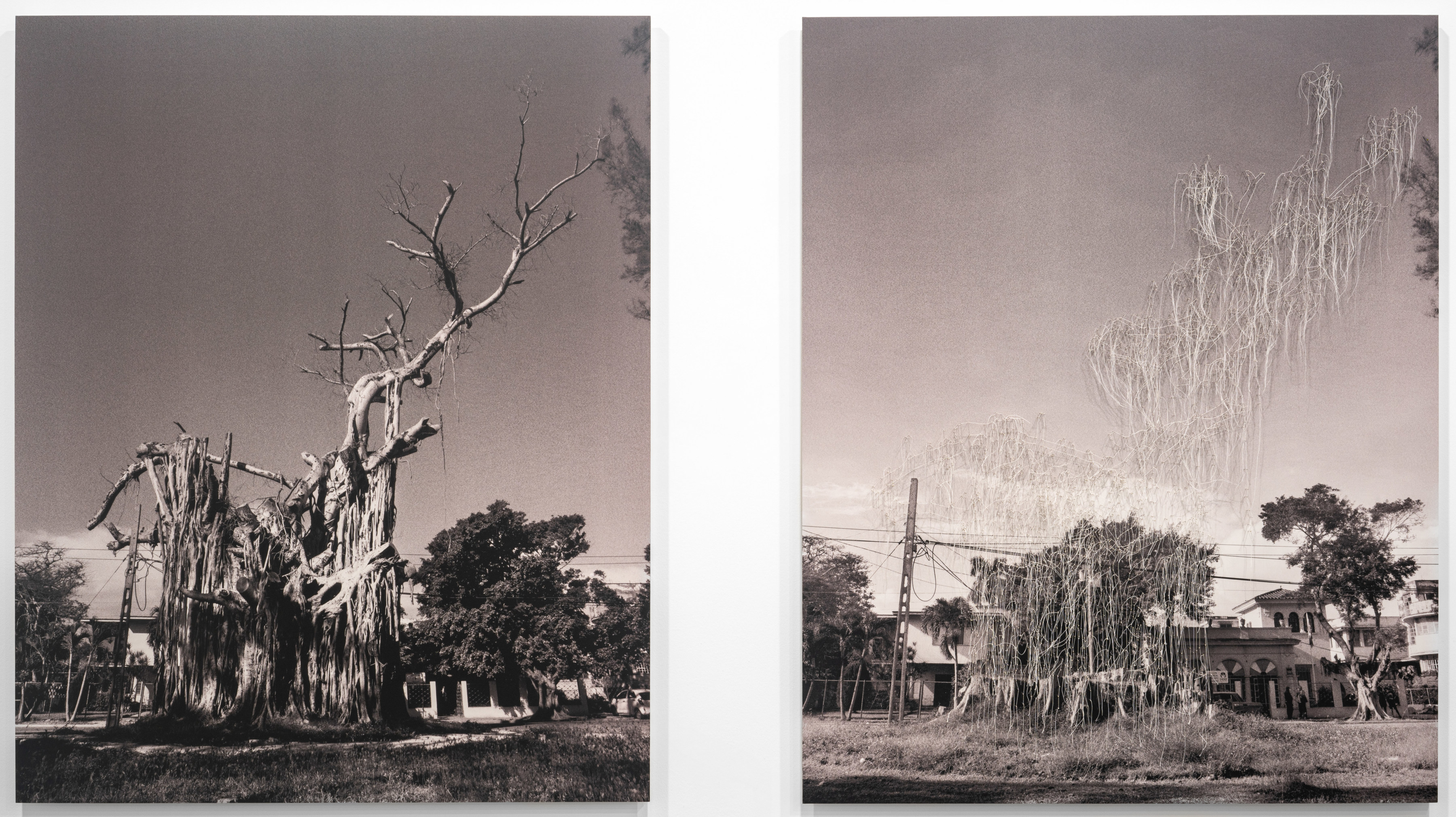
Through a multidisciplinary approach, Carlos Garaicoa addresses issues of culture and
politics with a reflexive lens into architecture, urbanism and history. In his essay,
‘Between Apparatus and Subjectivity: Carlos Garaicoa’s Post-Utopian Architecture’,
Okwui Enwezor described his practice, “Garaicoa is perhaps one of the most significant
artists of his generation to develop a sustained aesthetic and analytical framework that
would fuse the heritage of modern Cuban art and its complex political structure.”
Garaicoa combines photographs, drawings and mixed media as forms of intervention to
examine architecture and urbanism as mirrors of political reality and social
development.
Through black and white photographs, he merges imagery of dilapidated
buildings and structures with imaginary buildings whose construction was never
completed. The work is a form of criticism against the government, which has not
prevented the decay of Havana, since the Cuban revolution. For various years,
Garaicoa has been working on a series of black and white mural photographs of
different buildings in Havana integrated with thread drawings. In his work, what may
seem at first glance as diametrical opposition produces generative intrapsychic tensions
that can be explored and reconfigured —cityscape against nature, history against
futurity, reconstruction and ruination— sitting squarely at the centre of these tensions.
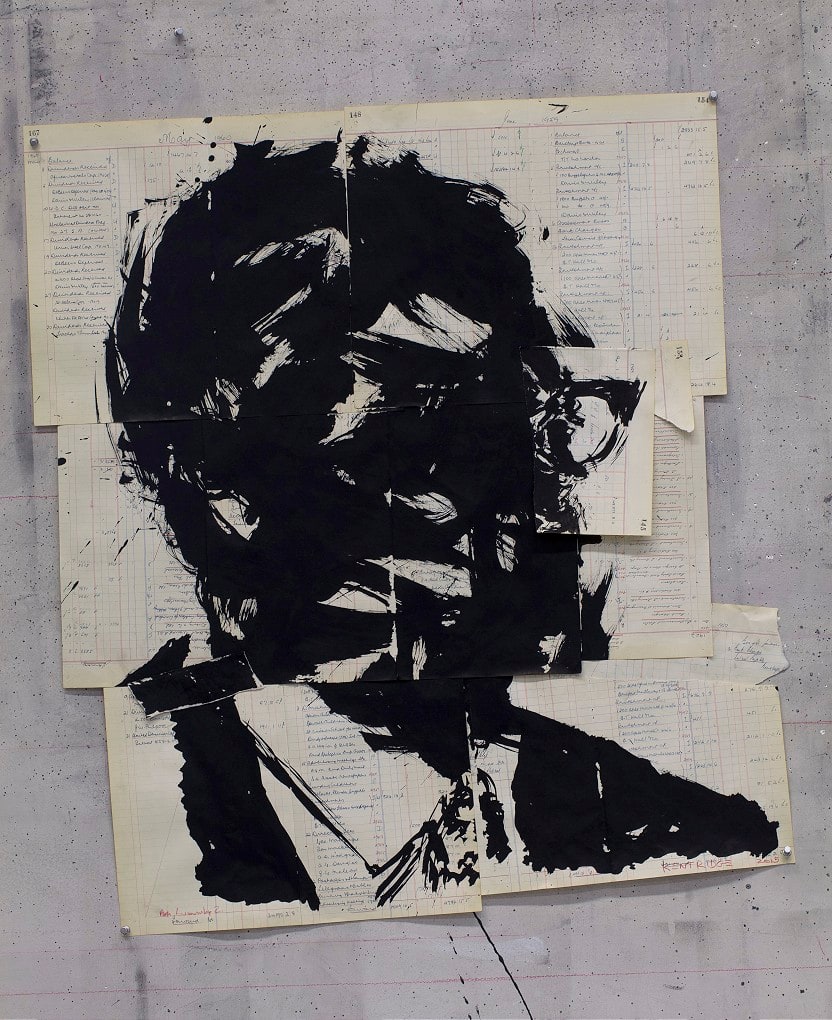
William Kentridge
Untitled (Patrice Lumumba II)
2015
Indian Ink on found pages
Work: 86.5 x 80.5 cm
Frame: 104.5 x 91 x 5 cm
Unique
The project began with an invitation to show Kentridge’s work in a museum in Beijing.
Kentridge writes,
“What is it in my work that would interest people there? I wanted both to find a link to it and to make a work that would refer to this question. Drawing, film, performance, posters, sculptures - all was possible, everything was open. The project begins, as many do, with distracted reading and looking. I read the books of Lu Xun, a modernist whose sensibility placed him with Japanese writer Aktagawa and European writers in the tradition of the absurd modern like Gogol and Kafka. Books of revolutionary posters. Here the language pulled me in, the exhortations, the instructions, the clamor of incredible and unstoppable enthusiasm.”
Rooted in the extensive research into the intellectual, political, and social history of modern China, from Lu Xun to revolutionary theater, Notes Towards a Model Opera explores dynamics of cultural diffusion and metamorphosis through the formal prism of the eight model operas of the Cultural Revolution.
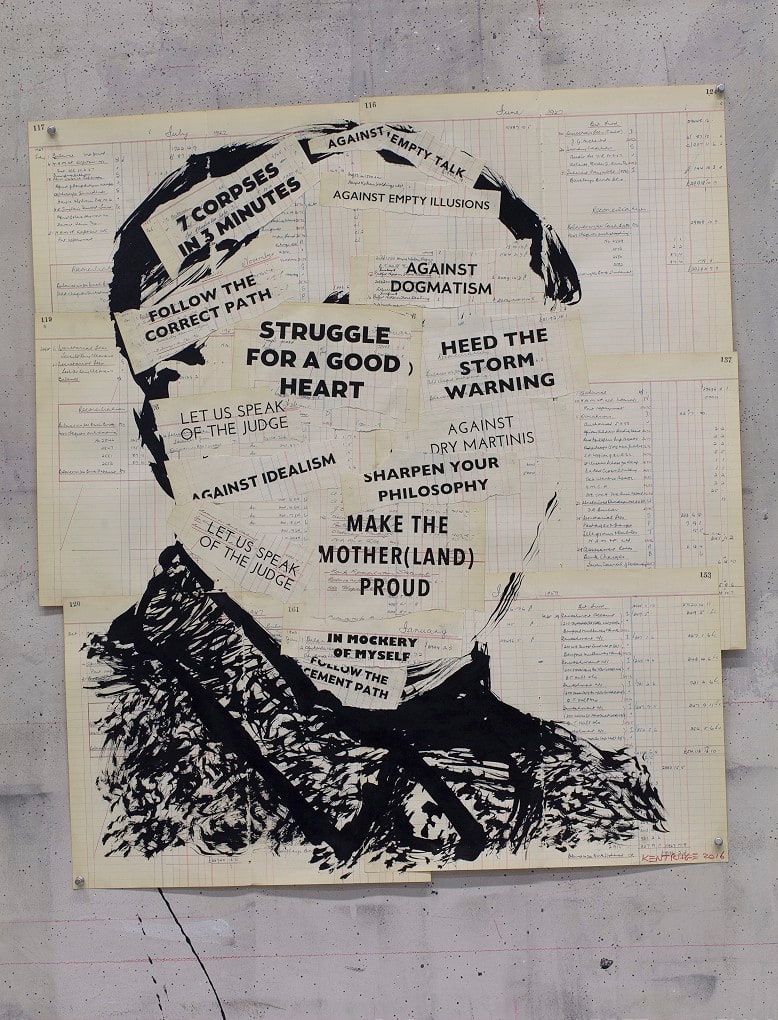
William Kentridge
Untitled (Against Dogmatism)
2016
Indian ink on found pages
Work: 85.5 x 77 cm
Frame: 104.5 x 90.5 x 5 cm
Unique
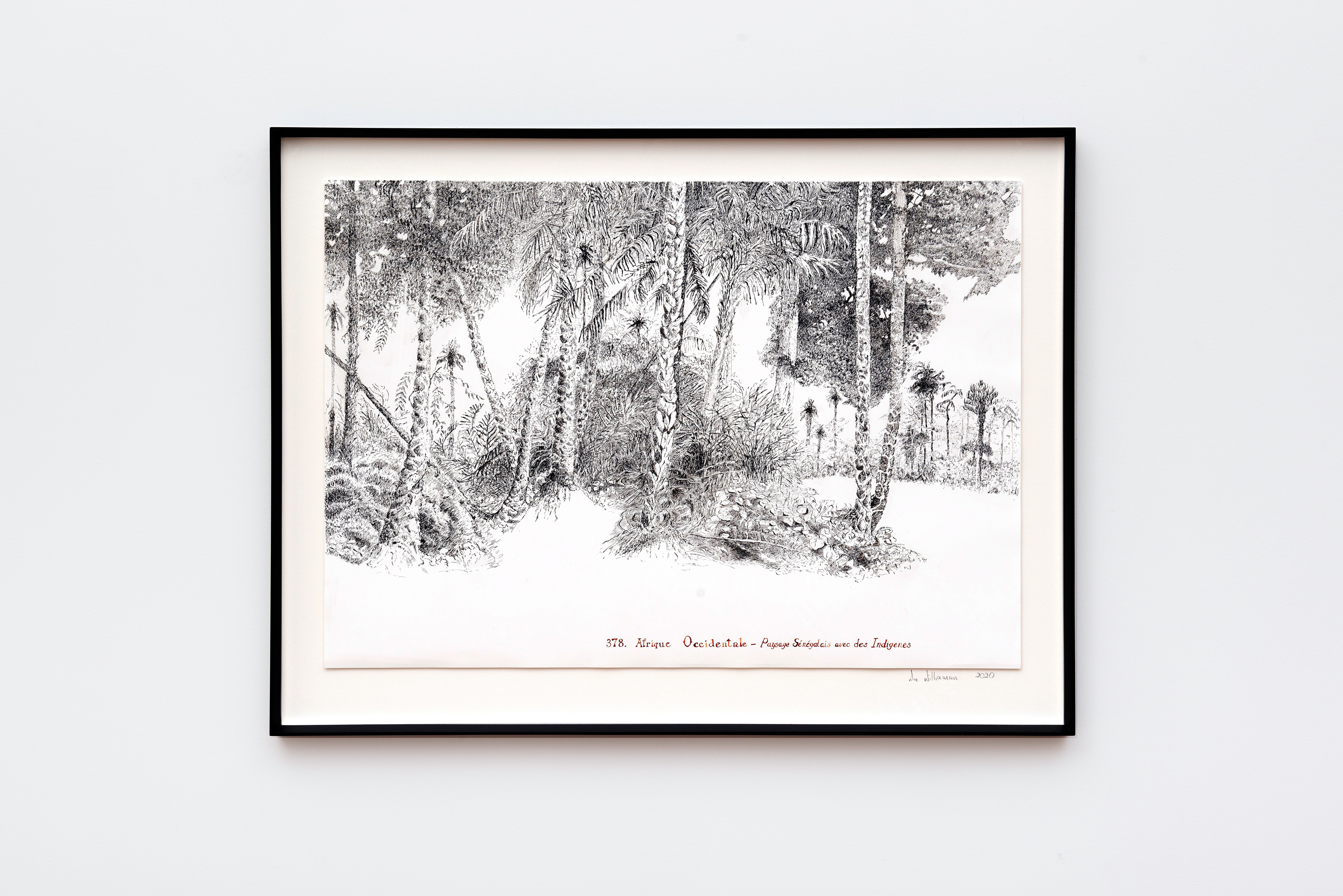
Sue Williamson
Postcards from Africa: Senegalese countryside
2020
Indian ink on Yupo synthetic archival paper, museum glass
Work: 70 x 100 cm
Frame: 87 x 114.5 cm
Unique
Postcards from Africa series considers a critical moment in history and wrestles with the
complex history of colonial expansion and conquest captured through the postcard
industry. It also continues Williamson’s investigation into the history of slavery,
dispossession and displacement, beginning with her 1997 installation, Messages from
the Moat, which was a detailed record of the buying and selling of enslaved people in
the Cape of Good Hope, and continued with Messages from the Atlantic Passage
(2017) which referenced old shipping records to focus on the trans-Atlantic slave trade.
In each drawing within the series, signs of habitation remain visible —dwellings, boats,
a pile of coconuts, baskets — but the people who appeared on the original postcard no
longer appear. The absence of the people from the landscape presents an
uncomfortable tension from which a series of questions emerge — where are the
people who used to live here? What happened to them? These questions point to the
complexity of subverting the colonial gaze —how does one challenge the gaze while
also taking care not to perpetuate violence through recirculation of images that re-
invoke their original racist and oppressive context?
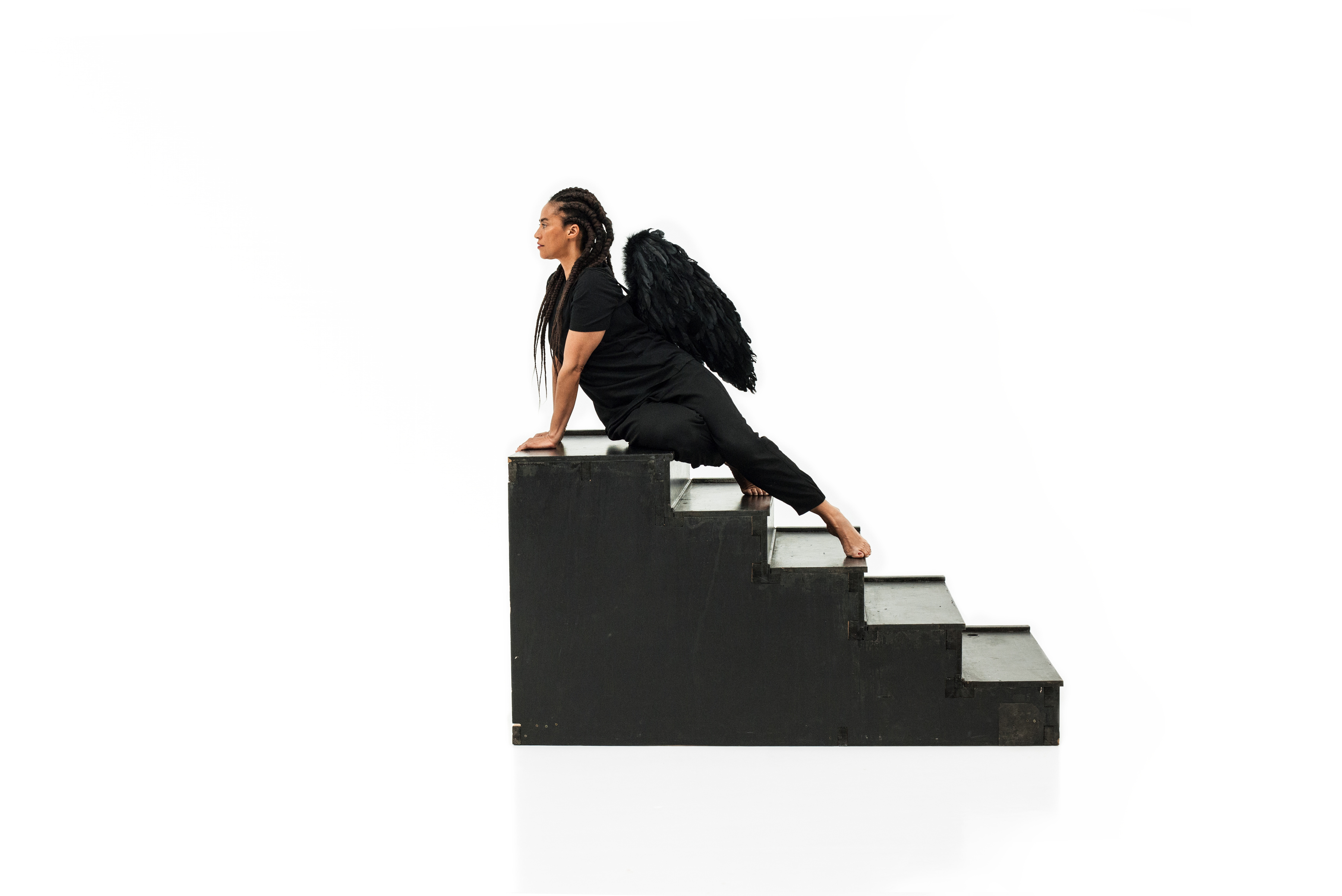
Grada Kilomba
Heroines, Birds and Monsters series, Sphinx Act I
2020
Archival pigment print on cotton paper mounted on
aluDibond
Work: 100 x 150 cm
STD 1/5
Edition of 5
Kilomba’s distinctive practice draws on the repressed history of colonialism and its traumatic legacy to create new forms of knowledge. In her new series of photographic works Heroines, Birds and Monsters, Kilomba carefully captures the complexities of the characters in her video trilogy, A World of Illusions (2019); a series of filmic installations in which the artist brings the African oral tradition of storytelling into a contemporary context to illuminate memories and realities of the postcolonial world.
Through this work, Kilomba poses the questions; “What if history has not been told properly? What if only some of its characters have been revealed as part of the narrative? And what if our history is haunted by cyclical violence precisely because it has not been buried properly?”
Kendell Geers’ series of bronze sculptures Flesh of the Spirit, is a commentary and interpretation on the fetishisation of African objects. As a white South African artist, Geers questions how recent history has constructed African identity through apartheid and the post apartheid period. Reworking these fetishised objects into bronze sculpture, Geers suggests some of the vanity and status the ‘primitive’ has cultivated in Western culture. Geers has always worked closely with his roots as an African artist in an exorcism of identity, throwing his white African roots up against the wall of sociopolitical interrogation. Being both white and African, an artist living in exile, a freedom fighter who grew up in struggle against Apartheid, his work is difficult to define in singular terms, always layered with contradiction and contrast. For Geers, the most pressing issue that art faces today is the reanimation of spirit, to return art to its spiritual function, the intercessor between worlds. Artists, shamans and priests have been drawn to the spiritual and healing properties of resins in their work. The natural resins like Myrrh and Oliban (Frankincense) favored by the ancients have since given way to synthetic resins as the needs of industrialization and global consumption have eclipsed the need to respect our environment.
“Like water slipping through my fingers, my art is about and materializing spirit." - Kendell Geers























